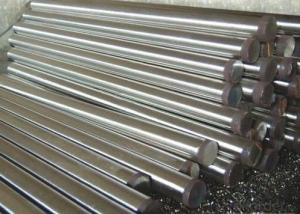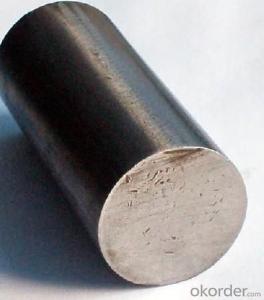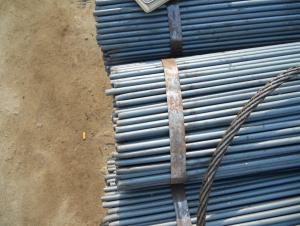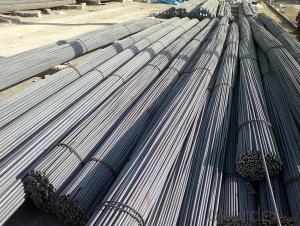Carbon steel round bar for construction
- Loading Port:
- Tianjin
- Payment Terms:
- TT or LC
- Min Order Qty:
- 25 m.t.
- Supply Capability:
- 100000 m.t./month
OKorder Service Pledge
OKorder Financial Service
You Might Also Like
Product Description:
OKorder is offering carbon steel round bar for construction at great prices with worldwide shipping. Our supplier is a world-class manufacturer of steel, with our products utilized the world over. OKorder annually supplies products to European, North American and Asian markets. We provide quotations within 24 hours of receiving an inquiry and guarantee competitive prices.
Product Applications:
Carbon steel round bar are ideal for structural applications and are widely used in the construction of buildings and bridges, and the manufacturing, petrochemical, and transportation industries.
Product Advantages:
OKorder's steel round bar RB are durable, strong, and resist corrosion.
Main Product Features:
· Premium quality
· Prompt delivery & seaworthy packing (30 days after receiving deposit)
· Corrosion resistance
· Can be recycled and reused
· Mill test certification
· Professional Service
· Competitive pricing
Product Specifications:
1. Grade: Q235, SS400, S235JR, A36
2. Sizes: Diameter: 6mm-150mm; Length: 6m, 9m, 12m or as customer’s request
3. Type: Mild steel; Low carbon steel
4. Shape: Round bar, solid bar of steel with circular section
5. Technique: Hot rolled or cold drawn
6. Mass: Mass(kg/m) = Diameter(mm)×Diameter(mm)×0.00617
Steel Type | Maximum forging temperature (°F / °C) | Burning temperature (°F / °C) |
1.5% carbon | 1920 / 1049 | 2080 / 1138 |
1.1% carbon | 1980 / 1082 | 2140 / 1171 |
0.9% carbon | 2050 / 1121 | 2230 / 1221 |
0.5% carbon | 2280 / 1249 | 2460 / 1349 |
0.2% carbon | 2410 / 1321 | 2680 / 1471 |
3.0% nickel steel | 2280 / 1249 | 2500 / 1371 |
3.0% nickel–chromium steel | 2280 / 1249 | 2500 / 1371 |
5.0% nickel (case-hardening) steel | 2320 / 1271 | 2640 / 1449 |
Usage and Applications of Carbon Steel Round Bar
Carbon steel round bar is the most common form of steel because its price is relatively low while it provides material properties that are acceptable for many applications, more so than iron. It is often used when large quantities of steel are needed, for example as structural steel. The density of this product is approximately 7.85g/cm³ and the young's modulus, like all steels.
Packaging & Delivery of Carbon Steel Round Bar
Packaging Detail: All goods are packed in bundle with steel strips and shipped by break bulk vessel or container (depend on target market and different ports)
Delivery Detail: 45 days
Trade terms: FOB, CFR, CIF
MOQ: 25 tons per specification; we can negotiate the quantity if the specification is normal or we have stock of one specification.
Weight: The price invoicing on theoretical weight basis or actual weight basis depends on customer’s request.
Shipment: The shipment of bulk break or container is depends on customer’s request and the situation of the port of destination.
Documents given: Full set of original clean on board bill of lading; Original signed commercial invoice; Original packing list; Policy of insurance; Certificate of origin and what the target market needs.
Production Flow of Carbon Steel Round Bar
1. The common processes are preheated forging quenching, dual refinement solution process, cooling quenching and isothermal quenching. We use heat treatment for dual refinement solution process. The main measures process is high temperature solution and refinement cycle. High temperature solution can improve the carbide morphology and particle size. The aim is to make the loop refinement ultrafine austenite grains.
2. EAF+LF+VD+ Forged+ Heat Treatment
FAQ:
Q1: How do we guarantee the quality of our products?
A1: We have established an advanced quality management system which conducts strict quality tests at every step, from raw materials to the final product. At the same time, we provide extensive follow-up service assurances as required.
Q2: What makes stainless steel stainless?
A2: Stainless steel must contain at least 10.5 % chromium. It is this element that reacts with the oxygen in the air to form a complex chrome-oxide surface layer that is invisible but strong enough to prevent further oxygen from "staining" (rusting) the surface. Higher levels of chromium and the addition of other alloying elements such as nickel and molybdenum enhance this surface layer and improve the corrosion resistance of the stainless material.

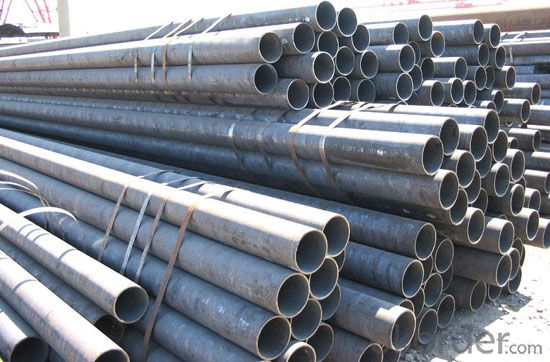
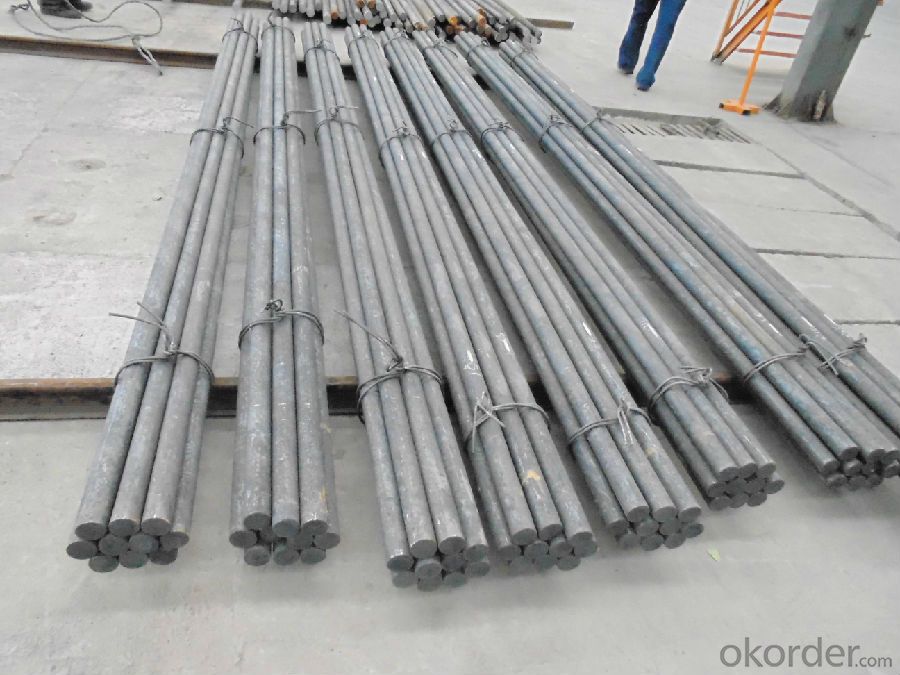
- Q:How do you calculate the deflection of a steel round bar?
- To calculate the deflection of a steel round bar, you need to consider various factors such as the bar's length, diameter, and the applied load. The deflection of a bar refers to the amount it bends or flexes under a specific load. The deflection can be determined using the formula for beam deflection, which is derived from Euler-Bernoulli beam theory. The formula is as follows: δ = (F * L^3) / (48 * E * I) Where: - δ represents deflection - F is the applied load - L is the length of the bar - E is the modulus of elasticity of the steel material - I is the moment of inertia of the round bar To calculate the moment of inertia (I) for a round bar, you can use the formula: I = (π * D^4) / 64 Where: - I is the moment of inertia - D is the diameter of the round bar By substituting the values into the formula, you can calculate the deflection of the steel round bar under the given load. It is important to note that these calculations assume the bar is perfectly elastic and obeys the principles of linear elasticity.
- Q:Is round steel bar round steel?
- Yes.From the shape of points for the light round steel, crescent steel, rebar.From the strength of reinforcement is divided into one level (235), two (335), three (435), four (435)Cold drawn from the production process (first tensioning and long pull method), cold and so on
- Q:What are the different types of steel round bars used in the automotive steering systems?
- There are several different types of steel round bars commonly used in automotive steering systems, each with their own unique properties and advantages. 1. Carbon Steel Round Bars: These are the most commonly used type of steel round bars in automotive steering systems. They offer good strength and durability, making them suitable for various steering components such as tie rods and drag links. Carbon steel round bars are also cost-effective and readily available, making them a popular choice in the automotive industry. 2. Alloy Steel Round Bars: Alloy steel round bars are made by adding various alloying elements such as chromium, nickel, and molybdenum to carbon steel. This enhances their strength, hardness, and wear resistance. Alloy steel round bars are often used in high-stress areas of the steering system where extra strength is required, such as in steering shafts and steering knuckles. 3. Stainless Steel Round Bars: Stainless steel round bars are known for their excellent corrosion resistance, making them suitable for steering components exposed to harsh environments or moisture. They are commonly used in steering system parts like steering column shafts and tie rod ends. 4. Tool Steel Round Bars: Tool steel round bars are used in specialized steering system components that require high hardness, wear resistance, and toughness. These bars are often used in the manufacturing of steering gears and other precision steering components. 5. High-Strength Low-Alloy (HSLA) Steel Round Bars: HSLA steel round bars are a type of alloy steel that provides a good balance between strength, toughness, and formability. They are commonly used in lightweight steering system components to reduce weight while maintaining structural integrity. Overall, the choice of steel round bars in automotive steering systems depends on factors such as the specific application, desired strength, durability, and corrosion resistance. Manufacturers carefully select the appropriate steel type to ensure optimal performance and safety in steering systems.
- Q:Can steel round bars be used in food processing applications?
- No, steel round bars are not suitable for food processing applications as they can corrode and contaminate the food. Stainless steel is typically used in such applications due to its corrosion resistance and hygienic properties.
- Q:What are the maximum allowable stresses for steel round bars?
- The maximum allowable stresses for steel round bars are influenced by various factors, including the grade of steel, the type of loading, and the design code being adhered to. Typically, the maximum allowable stress for steel round bars is determined by considering the yield strength of the steel. The yield strength signifies the stress at which permanent deformation or yielding of the material takes place. Distinct grades of steel possess different yield strengths. For instance, mild steel usually exhibits a yield strength of approximately 250 MPa, while high-strength low-alloy (HSLA) steel can have a yield strength reaching up to 550 MPa. To ascertain the maximum allowable stress, it is customary to apply a safety factor to the yield strength. This safety factor accounts for uncertainties in material properties, loadings, and potential variations in manufacturing processes. The specific safety factor employed can vary based on the application and the design code being followed. For instance, in structural steel design, the American Institute of Steel Construction (AISC) prescribes a safety factor of 1.67 for the yield strength. Thus, the maximum allowable stress would be the yield strength divided by 1.67. In order to determine the appropriate maximum allowable stresses for steel round bars in specific applications, it is crucial to refer to relevant design codes, standards, or engineering specifications.
- Q:Can steel round bars be used in the hospitality industry?
- Certainly! Steel round bars are indeed applicable in the hospitality field. Possessing versatility and durability, they are well-suited for a variety of purposes within this industry. These bars can be employed in the construction of furniture items like chairs, tables, and bar stools, as well as in the creation of decorative elements such as railings, light fixtures, and signage. Moreover, steel round bars offer exceptional strength and stability, thus ensuring the safety of both guests and staff members. Furthermore, they can be easily customized to align with the preferred aesthetic and design choices of different hospitality establishments. All in all, steel round bars prove to be a dependable and pragmatic option for the hospitality industry, thanks to their robustness, versatility, and visual appeal.
- Q:What are the different treatments available for steel round bars?
- Depending on the desired properties and applications, there are several treatment options available for steel round bars. Some commonly used treatments are as follows: 1. Altering the mechanical properties of steel round bars can be achieved through heat treatment. This involves heating the bars to a specific temperature and then cooling them rapidly or slowly. By doing so, hardness, strength, toughness, and resistance to wear and corrosion can be improved. 2. To increase hardness, quenching can be employed. This entails rapidly cooling the heated steel round bars in a liquid medium, such as water or oil. Following quenching, tempering is carried out by reheating the steel to a lower temperature. This reduces brittleness and enhances toughness. 3. Surface hardening is a treatment method used to enhance the hardness of the outer layer of steel round bars while maintaining a tough and ductile core. Common techniques for surface hardening include carburizing, nitriding, and induction hardening. 4. Cold working involves deforming the steel at room temperature through processes like rolling, drawing, or extrusion. This treatment strengthens and increases the hardness of the steel round bars. Additionally, it improves dimensional accuracy and surface finish. 5. To enhance resistance to corrosion and wear, a protective coating can be applied to steel round bars. Zinc plating, galvanizing, and various types of paint or epoxy coatings are commonly used for this purpose. 6. Shot blasting is a treatment technique where small metallic or abrasive particles are shot at high speeds onto the surface of the steel round bars. This process removes contaminants, scale, and rust, resulting in a clean and polished surface. It is important to consider the specific requirements of the steel round bars and the intended application when choosing a treatment method. Consulting with experts or metallurgists is recommended to determine the most suitable treatment for a particular situation.
- Q:Can steel round bars be used for making agricultural equipment?
- Yes, steel round bars can be used for making agricultural equipment. Steel round bars are known for their high strength and durability, making them suitable for heavy-duty applications in the agricultural industry. They can be used to manufacture various agricultural equipment such as plows, tillers, cultivators, harrows, and seeders. The strength of steel round bars allows these equipment to withstand the harsh conditions in the field, including the impact of rocks and hard soil. Additionally, steel round bars can be easily shaped and welded, providing flexibility in designing and customizing agricultural equipment according to specific requirements. Overall, steel round bars are a reliable and cost-effective material choice for making agricultural equipment due to their strength, durability, and versatility.
- Q:Can steel round bars be heat treated after machining?
- Yes, steel round bars can be heat treated after machining. Heat treatment is a process used to alter the physical and mechanical properties of a material, including steel, by subjecting it to controlled heating and cooling. Machining is the process of shaping or removing material from a workpiece using various tools and techniques. Heat treatment can be performed on steel round bars after machining to improve their mechanical properties, such as hardness, strength, and toughness. The specific heat treatment process used will depend on the desired properties and the specific type of steel being used. Common heat treatment methods for steel include annealing, tempering, quenching, and normalizing. It is important to note that the machining process may introduce stresses into the steel round bar, which can affect the effectiveness of the heat treatment. Therefore, it is essential to carefully consider the machining and heat treatment sequence to ensure optimal results. Additionally, proper precautions should be taken during machining to minimize the introduction of excessive heat or damage to the material, as this can impact the effectiveness of heat treatment.
- Q:How do steel round bars perform in outdoor or marine environments?
- Steel round bars generally perform well in outdoor or marine environments due to their inherent strength and corrosion resistance. The composition of steel, particularly stainless steel, enables it to withstand exposure to moisture, saltwater, and other harsh elements without significant degradation or rusting. This makes steel round bars a dependable choice for construction, infrastructure, and marine applications where durability and longevity are crucial.
1. Manufacturer Overview |
|
|---|---|
| Location | |
| Year Established | |
| Annual Output Value | |
| Main Markets | |
| Company Certifications | |
2. Manufacturer Certificates |
|
|---|---|
| a) Certification Name | |
| Range | |
| Reference | |
| Validity Period | |
3. Manufacturer Capability |
|
|---|---|
| a)Trade Capacity | |
| Nearest Port | |
| Export Percentage | |
| No.of Employees in Trade Department | |
| Language Spoken: | |
| b)Factory Information | |
| Factory Size: | |
| No. of Production Lines | |
| Contract Manufacturing | |
| Product Price Range | |
Send your message to us
Carbon steel round bar for construction
- Loading Port:
- Tianjin
- Payment Terms:
- TT or LC
- Min Order Qty:
- 25 m.t.
- Supply Capability:
- 100000 m.t./month
OKorder Service Pledge
OKorder Financial Service
Similar products
New products
Hot products
Related keywords
